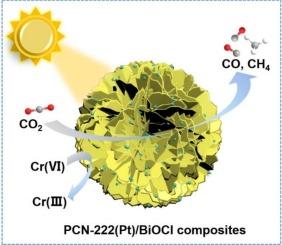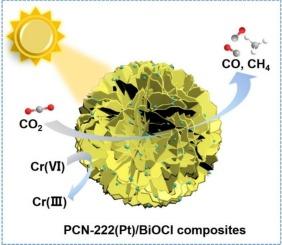内置电场驱动电荷分离的PCN-222(Pt)/BiOCl异质结的构建提高了光催化性能
IF 6.9
2区 材料科学
Q2 CHEMISTRY, PHYSICAL
引用次数: 0
摘要
光催化是一种减轻温室效应和环境污染的可持续方法。然而,光催化剂的光吸收能力较弱,光诱导载体的分离效率较差,光催化性能不理想。在此,PCN-222(Pt)通过回流过程被加载到由纳米片组装而成的BiOCl纳米花上。PCN-222(Pt)/BiOCl异质结构增强了CO2吸附,促进了光生载体的迁移,从而提高了CO2和Cr(VI)的光还原活性。优化后的PCN-222(Pt)/BiOCl-2在辐照5 h后CO生成率为41.88 μmol g−1。此外,PCN-222(Pt)/BiOCl-2在80 min的可见光照射下,对Cr(VI)的去除率也达到95.89 %。此外,利用原位FT-IR研究了CO2光还原过程中CO2分子的演化过程,并通过捕获实验探索了Cr(Ⅵ)还原中的活性物质。本研究为提高光催化性能提供了有益的参考。本文章由计算机程序翻译,如有差异,请以英文原文为准。


Construction of PCN-222(Pt)/BiOCl heterojunction with built-in electric field drive charge separation for enhanced photocatalytic performance
It is a sustainable method to mitigate the greenhouse effect and environmental pollution through photocatalysis. However, photocatalysts suffer from low light absorption and poor separation efficiency of photoinduced carriers, which shows unsatisfactory photocatalytic performance. Herein, the PCN-222(Pt) has been loaded on BiOCl nanoflowers assembled from nanosheets through the heating process of oil bath. The PCN-222(Pt)/BiOCl heterostructures show promoted CO2 adsorption capacity and improved migration efficiency of photogenerated carriers, resulting in enhanced CO2 and Cr(VI) photoreduction activities. The optimized PCN-222(Pt)/BiOCl-2 shows a CO generation rate of 41.88 μmol g−1 after irradiation for 5 h. Besides, the PCN-222(Pt)/BiOCl-2 also shows a higher Cr(VI) removal efficiency of 95.89% under irradiation for 80 min with visible light. Furthermore, the evolution process of CO2 molecules in the CO2 photoreduction process has been investigated by in-situ FTIR, and the active species in Cr(VI) reduction was explored through capture experiments. This work offers a promising available reference for enhancing photocatalytic performance.
求助全文
通过发布文献求助,成功后即可免费获取论文全文。
去求助
来源期刊

Applied Surface Science
工程技术-材料科学:膜
CiteScore
12.50
自引率
7.50%
发文量
3393
审稿时长
67 days
期刊介绍:
Applied Surface Science covers topics contributing to a better understanding of surfaces, interfaces, nanostructures and their applications. The journal is concerned with scientific research on the atomic and molecular level of material properties determined with specific surface analytical techniques and/or computational methods, as well as the processing of such structures.
 求助内容:
求助内容: 应助结果提醒方式:
应助结果提醒方式:


